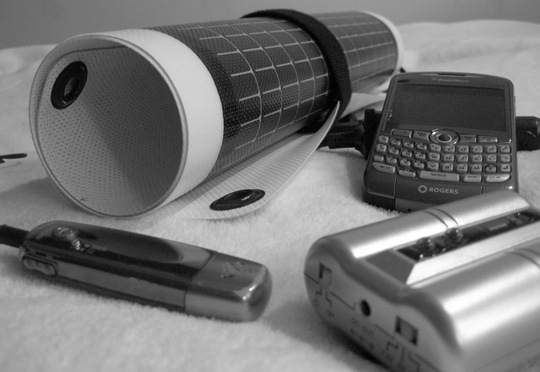All photos by James D. Schwartz / The Urban Country
Imagine sitting on a dock on a beautiful lake with a laptop, performing your everyday job functions. You don’t ever have to worry about commuting to work and the only factor that can deter you from staying outside is the weather.
This is my dream – and with today’s technology for telecommuting, this is becoming closer to reality. For years – even decades – many people around the world have already been doing some form of telecommuting – from the remote software development “factories” in India, to stock brokers trading from the comfort of their own home.
Telecommuting dates back to the 1970’s where early telecommuters would use telephone lines and a network bridge to connect in remote locations.
Telecommuting has obvious environmental benefits and most people would agree that it results in higher employee satisfaction. In my experience, I’ve found that telecommuting helps boost productivity as well.
Telecommuting does however have its limitations (outside of the obvious limitation of not having face-to-face contact with your co-workers). You typically need to have an active phone connection, electrical outlet and an Internet connection. With large-scale investments in cellular tower infrastructure and a major increase in network speed, it’s now conceivable to work outside of your typical indoor “terminal”. Working outdoors or in a remote location is now a realistic possibility.
With even more groundbreaking technology, new barriers in telecommuting are being overcome.
A new technology I recently became acquainted with is rollable solar power technology. Prior to my 11-day kayak trip earlier this summer, I was researching personal solar panels to keep my electronics charged throughout my trip – knowing that I wouldn’t have easy access to electrical outlets for the entire 11 days.
I spent hours trying to find a portable solar panel that met my needs both in its physical dimensions and energy output.
I visited my favourite outdoors store Mountain Equipment Co-Op, but couldn’t find anything with sufficient power output. The solar panels they carried were only capable of about 1.5 watts output – which wouldn’t have met my electricity needs.
So I searched online and came across the PowerFilm line of rollable solar panels. Manufactured in Iowa, PowerFilm inc. offers several versions of its rollable solar panels with different output – 7 watt, 14 watt, 21 watt and 28 watt. The physical width of each solar panel is the same for each model, but the higher the output, the longer the panel. For example, the 7 watt panel that I purchased is 23 inches long, while the 28 watt model is 79 inches long (close to 7 feet).
The PowerFilm rollable panel is a great match for a kayak because you can safely unroll the panel and strap it to the top of the kayak to charge your electronics while you paddle under the hot sun. It is weather-proof and built with marine-grade connectors, so I didn’t have to worry about the panel getting wet from the waves.
Instead of plugging my Blackberry and MP3 player directly into the solar panel, I brought with me a battery pack that would store the solar electricity and at night I would charge my electronic devices. Plugging your electronic devices directly into the solar panel is another option that helps reduce the eventual battery waste that would result from the battery pack but sometimes it isn’t feasible to use your electronics while they are charging.
One word of caution I can offer is to be cautious to keep your electronics dry. During my trip, I had a leak in a ziplock bag that resulted in a non-working battery pack for the remainder of the trip. It wasn’t until I dried out the battery pack for a few days before it started charging again. Because the battery pack was a single point of failure, I was “offline” for the last 4 days of my trip so I lost my internet connection and GPS tracking.
This was more a result of my own negligence than anything else – the solar panel became wet several times on the trip without its performance being affected.
The PowerFilm rollable solar panel creates new opportunities in the area of telecommuting. The scenario of working on the dock on a beautiful lake is very feasible with the PowerFilm panel charging your laptop and phone. It helps you stay mobile so if (for example) you get tired of working on the dock, you can pick up your things and move to the beach.
The US Military is already capitalizing on the opportunities that the PowerFilm panel creates. The military uses these solar panels in remote operational tents in Iraq and Afghanistan to keep their gadgets charged. This provides flexibility on where army bases can be setup and allows the army to be more agile and mobile.
I’m committed to making this new form of telecommuting in a remote location feasible by investing in and testing the technology that can make it happen. In future articles I’ll be profiling my progress on making this a reality.
If you’re in the market for a solar panel, you have my stamp of approval on the PowerFilm technology – whether you use it for camping, paddling trips, cycling, or for your cottage, you won’t be disappointed in this product.
The R-7 PowerFilm solar panel can be purchased from modernoutpost.com for $159.99, or from homedepot.ca or for $249.99. According to James Alden from Transformative Technologies Inc., the PowerFilm product line should reach mainstream stores in Canada in 2010.





Hey Jim,
there’re few things I love more than writing code and correspondence on the balcony, on the deck or in some far flung corner of my back yard.
BTW – you should be able to speed up the drying time of accidentally soaked electronics by packing them in a container of … rice!
cheers!
Excellent post! Thanks for the details here. I am glad I came across such an interesting post here. https://www.goemployed.com/